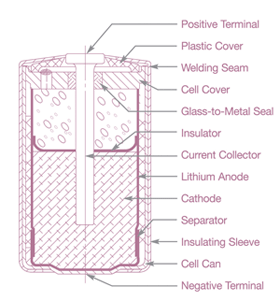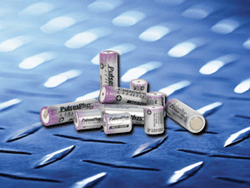Lithium thionyl chloride batteries can power remote wireless sensors for over 20 years
BY SOL JACOBS
Tadiran Batteries
Port Washington, NY
http://www.tadiranbat.com
In 1984, Hexagram, a leading manufacturer of utility meters, played a pioneering role in the development of remote wireless sensors when they introduced their first generation of automatic meter reading (AMR) devices for the utility market. Powered by 1.8 AH, AA-size lithium thionyl chloride batteries, over 3 million of these devices have been deployed worldwide, and most continuing to operate on their original batteries after 24 years, with laboratory tests confirming that the batteries have retained over 25% of their original capacity. This long-term performance is especially critical to utility companies, as extended battery life translates into higher productivity and profitability by eliminating the need for system-wide battery change outs.
This example also has broader implications for design engineers who are increasingly being challenged to develop long-term, self-contained power management solutions untethered to ac power sources, especially in instances where access to ac power is unavailable, undesirable or cost prohibitive. The growing list of such applications includes system control and data acquisition (SCADA), data loggers, measurement while drilling, oceanographic measurement and emergency/safety equipment.
Lithium batteries are not created equal
Compared to consumer batteries such as alkaline, zinc-carbon-ammonium chloride (Leclanche cell), zinc-carbon-zinc chloride and zinc-air, lithium is better suited for remote sensor applications due to its intrinsic negative potential, which exceeds that of all other metals. The lightest non-gaseous metal, lithium offers the highest specific energy (energy per unit weight) and energy density (energy per unit volume) of all available battery chemistries. Lithium cells, all of which use a non-aqueous electrolyte, have normal open-circuit voltages (OCVs) between 2.7 and 3.6 V. The absence of water also allows certain lithium batteries to operate in extreme temperatures (-55C to 150C).
Within the lithium family of batteries there are three main types of primary battery chemistries — poly carbon monoflouride (Li/CFX), manganese dioxide (Li/MNO2 ), and lithium thionyl chloride (Li/SOCL2 ) — each offering unique advantages and disadvantages. As shown below, the maximum service life of these chemistries varies considerably:
Li/CFX – maximum service life 8 years
Li/MNO2 – maximum service life 8 years
Li/SOCL2 – maximum service life 20+ years

Fig. 1. Cross-section of a Li/SOCl2 battery.
Choosing the optimum lithium primary battery requires that design engineers carefully evaluate their power and performance requirements, from which they can develop a prioritized checklist of desired attributes such as voltage, capacity, size, weight and/or special packaging requirements, expected service life, temperature and/or environmental issues and cost. Special requirements such as the need for high current pulses or high discharge rate could also be important considerations. However, when extremely long battery life, extended temperature range, and reduced battery size and weight are all essential, the lithium battery of choice is lithium thionyl chloride, which is available in two styles: bobbin or spirally wound construction.
Spirally wound vs. bobbin type construction
A common challenge to both bobbin and spirally wound construction involves the non-aqueous electrolyte, which results in relatively high impedance. One solution is to increase the surface area using a spirally wound cathode. However, this results in certain trade-offs, as spirally wound construction offers reduced energy density (you now have more inactive material within the cell) and shorter operating life (with extra surface area you also get a higher self-discharge rate). As a result, spirally wound Li/SOC2 batteries are capable only of delivering an energy density of 800 Wh/l, a temperature range of -55C to 85C, and a maximum service life of about 10 years.
By contrast, bobbin-type Li/SOCL2 cells deliver far higher energy density (1,420 Wh/l), high capacity, a unique ability to withstand extreme temperatures (-55 to 150C) and extremely long service life of up to 20+ years due to low annual self-discharge (1% to 2% per year). High capacity, small size, and an ability to withstand broad fluctuations in pressure, temperature and shock make bobbin-type lithium thionyl chloride cells ideal for use in remote monitoring applications.
While the theoretical service life of a bobbin-type lithium thionyl chloride battery may be over 20 years, the actual service life varies based on the self-discharge rate, which is governed by the chemical composition of the electrolyte, the manufacturing processes used, as well as mechanical and environmental considerations. Self-discharge can also be negatively affected by high levels of impurities in the electrolyte. Extreme temperatures can also reduce battery performance by affecting voltage and self-discharge rate. Battery performance can also be hindered by impedance, which results from the internal resistance created by the electrolyte, the anode, and the cathode. Experienced battery manufacturers can control impedance by blending special additives into the electrolyte.
Battery life can also be extended during the product design phase. Figure 2 shows an example of a Meter Transmitter Unit (MTU) that is powered by improved high capacity XOL (eXtended Operating Life) lithium thionyl chloride batteries that feature 2.4 Ah capacity, with a self-discharge rate of approximately 1% per year. Hexagram STAR MTUs utilize narrow band radio frequency to communicate with networks of Data Collection Units (DCUs) mounted on buildings or utility poles located approximately 1 to 2 miles apart. A microcomputer stores programmable ID numbers, monitors usage, and senses tampering, and use of one-way transmission eliminated the need for a receiver, resulting in a less-complex lower-cost system. Hexagram STAR MTUs can achieve 20+ year service life due to low battery self-discharge, high capacity, and the elimination of a receiver required to listen for a “wake-up” transmission. Instead, a timer powers up the MTU, enabling it to transmit data at programmed intervals.

Fig. 2. Meter transmitter units are powered by XOL Li/SOCl2 batteries.
High-current pulse hybrid solutions
There are a growing number of applications that require high-current pulses, presenting technical challenges to both spirally wound and bobbin-type lithium batteries. Typically, these applications involve low continuous current (or no continuous current) coupled with high pulse currents of up to several amperes for a period of seconds up to 20 minutes.
Spirally wound lithium thionyl chloride batteries deliver the energy density demanded by high current pulse applications. However, this chemistry lacks the required capacity, and has a comparatively high-rate of self-discharge, which limits their long-term operation. Bobbin-type cells have the ideal capacity and energy density, but have two main drawbacks: severe passivation problems after storage at elevated temperatures, and low current due to its low rate design. To overcome these obstacles, PulsesPlus technology was developed by combining a bobbin-type primary cell with a patented high rate, low impedance hybrid layer capacitor (HLC). This hybrid system delivers high currents with an excellent safety margin. This is accomplished simply because the HLC can store up to 700 Wh/Kg of energy. The rate at which energy can be stored by the HLC varies from 280 A/s, with smaller HLCs, to 1,120 A/s. with larger size HLCs.

Fig. 3. Examples of the PulsesPlus batteries.
Evaluating battery suppliers
Design engineers also need to verify that the lithium thionyl chloride battery they specify can deliver as promised. With the rapid growth in imitation products now flooding the marketplace, extra vigilance is require to ensure product quality and authenticity, with 100% product traceability back to the original manufacturer. As part of the vendor selection process, it is recommended that potential battery suppliers be required to provide a list of customer references along with fully documented and verifiable test results for parameters such as battery pulse, low-temperature pulses, discharge and repeatability. Faithfully applying these and other common sense practices during the vendor selection process will help ensure years of trouble-free battery performance.
For more on batteries, visit http://electronicproducts-com-develop.go-vip.net/power.asp.
Related Products: Batteries
Advertisement
Learn more about Tadiran





